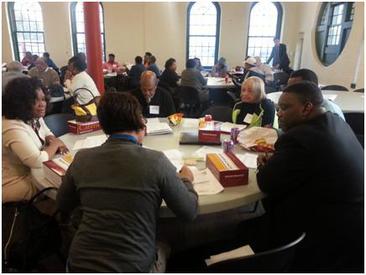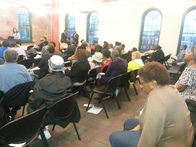|
Community
Planning Spotlight:
The East Baltimore Leadership Academy
On April 30th,
over 50 East Baltimore community members joined Citizen’s Planning &
Housing Association (CPHA) and the Department of Planning to kick-off an
exciting and dynamic capacity building workshop, The East Baltimore Leadership
Academy.
The East Baltimore Leadership Academy, a first in Baltimore, was conceived
of by Planning Department staff as a planning and community organizing workshop series for East
Baltimore residents. Joining us in this
vision and seeing the need for this type of capacity building were the Annie E.
Casey Foundation, who provided support, and our dedicated partner CPHA, who
helped bring this vision to fruition.

Over the
course of 3 days (April 30th, May 4 and May 8th),
approximately 150 participants participated in this intensive workshop with one
goal in mind – to equip themselves with essential leadership, community
engagement, and urban planning knowledge and tools that they could then use to
strengthen their communities.
Participants ranged from community organization
leaders, and non-profit representatives to neighborhood residents. On day one CPHA and Planning Department staff
gave participants an overview of what the Planning Department does and a primer on a number
of CPHA’s initiatives.
|

Day two
offered a menu of 11 courses for participants to choose from that were taught
by Planning and CPHA staff, as well as guest instructors. Course topics included an introduction to Zoning,
the development and legislative processes, sustainability, community engagement,
running an effective meeting, prioritizing issues and communication.

Day 3 was all about peer
learning and application. Participants
were placed in groups to work through 2 exercises, including a complex development
and community scenario that required them to use information from all of the
classes, as well as an exercise to begin identifying how the things they
learned could be applied to help improve their neighborhoods.
We were
delighted by the turnout and the excitement from the communities. Those that
attended all three days received certificates, and door prizes were given to the neighborhoods
with the largest turn-out. Our hope is
that this event will be a model for future capacity building opportunities in
other areas of the City related to Baltimore’s urban planning issues.
|
CIP Spotlight:
BDC and Ikaros Restaurant
Developing the CIP is a very important function of the Planning Department, and
the funded projects have the potential to transform communities. So each month
The Compass will highlight a project from the City’s Capital Improvement
Program (CIP). This month’s featured project is the new Ikaros
Restaurant.

On August 2, 2012, Ikaros
Restaurant moved into a new location at 4901 Eastern Avenue. The restaurant had an opportunity to expand
its operations by leasing a 10,000 square foot building at 4901 Eastern Avenue,
which formerly operated as a restaurant.
This property is located just one block east of its old location. The
Baltimore Development Corporation provided capital funding for improvements to the
more spacious location at 4901 Eastern Avenue.
The financing provided was key for retention of 16 full-time jobs,18
part-time jobs, and the addition of a banquet hall within the City.
City CIP Funds (GO Bonds)
$200,000
Private Investment
$300,000
Total Construction Costs:
$500,000
Uses of City Funds: Building
Improvements ($140,000), Furniture, Fixtures & Equipment ($60,000)
|
Is Green Space Good for Your Health? Help a student find out:
Meghan Hazer, a former Baltimore resident studying for her Masters Degree at the SUNY College of Environmental
Science and Forestry in Syracuse, NY, is researching how the urban environment
can impact our health.
She asked us to share this link to a survey on the potential impact of urban green space on health,
stress, and longevity.
Given Baltimore's increasing interest in Growing Green, why not help her out? Go to the survey using this link. |